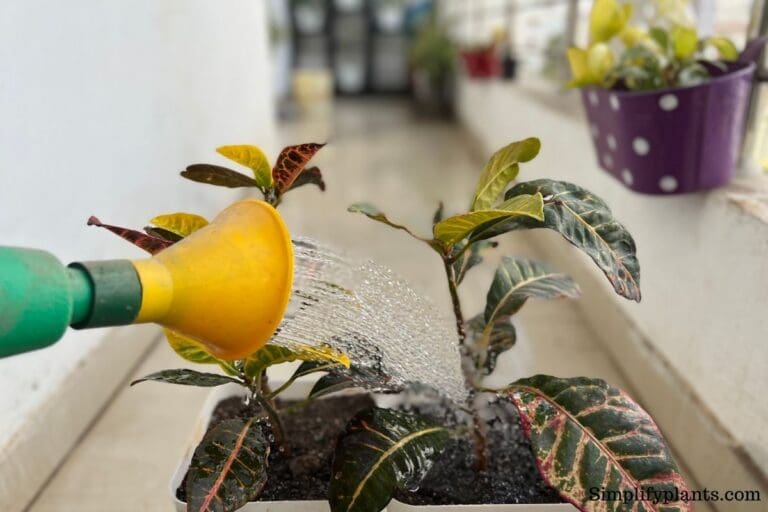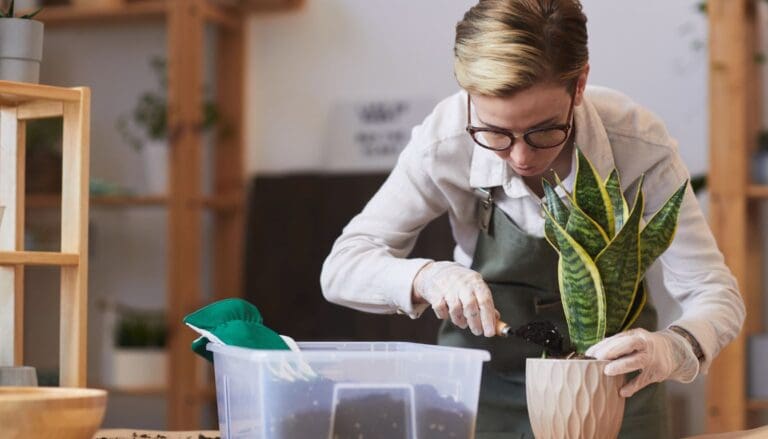How To Fix Root Rot In Fiddle Leaf Fig? (+ Causes+Prevention)
Root rot is a common yet serious problem found in almost all indoor plants. If you can diagnose the causes on time, you will be able to save your fiddle leaf fig from root rot. Let’s find out what root rot is and what you can do to fix this problem.
Root rot is when the roots of the plants start rotting or decomposing, which can lead to the death of the plant if not treated at the right time.
Overwatering is the primary reason behind root rot in fiddle leaf figs. Other causes include using the wrong soil mix and lack of proper drainage. To fix the root rot of a fiddle leaf fig, take the plant out of the pot, prune the damaged roots and repot the plant in a new pot with a fresh soil mix.
If you are unsure if your fiddle leaf fig has root rot, read this article to get all the information related to root rot.
Please note: Simplify Plants is reader-supported. Some links in the post are affiliate links and I get a commission from purchases made through links in the post.
How to tell if the fiddle leaf fig has root rot?

Some signs that show that your fiddle leaf fig might have a root rot:
- Mushy brown roots
- Unpleasant odor from soil
- Drooping stems
- Browning leaves
- Algae visible around the soil
Mushy brown roots – Healthy roots are crisp and dry. But if it starts becoming mushy or slimy in texture, it is a sign of root rot. The color is also an indication as healthy roots are primarily white, but a root prone to root rot will turn brown or black. Unhealthy roots are a sign of root rot.
Unpleasant odor from soil – A damp smell almost always accompanies root rot. If you check the soil, you might get a musty smell from the surface. If you don’t get a smell on the surface level, you might need to take the plant out of the pot, upon which you will get a musty or damp smell. These are clear signs of root rot.
Also read: How to get rid of smell in the potting soil?
Drooping stems – Drooping stems can be a sign of root rot in fiddle leaf figs.
Fiddle leaf figs have larger leaves on the top of the plant, making the stem droop down sometimes. If you notice an increase in drooping branches, it might be due to root rot.
Consider checking the soil and the roots whenever you notice such symptoms of the stems drooping or getting soft.
Browning leaves – The leaves of your fiddle leaf fig also show signs of root rot. You will notice small and brown spots on the leaves initially. These spots will start growing and will become dark brown or black.
The spots can show up anywhere on the leaves, sometimes the leaves’ edges and sometimes even the middle of the leaf.
Algae visible around the soil – You may notice mold or algae around the base of your fiddle leaf fig. Overwatering creates the perfect environment for this, and there might be a root rot deep down.
How to check fiddle leaf fig for root rot?

If you suspect root rot, you need to check the plant roots to make sure of it.
The first thing is to take the fiddle leaf fig out of the pot and examine the roots. Be careful while taking the plant out of the pot, as being harsh can damage the plant. Try not to jerk the stem out of the pot; instead, do it gently.
You can hold the stem of the plant and gently pull it out of the pot. If you find it hard, you can squeeze the pot’s edges so that the plant comes out.
You can run warm water over the roots to remove as much soil as possible without causing any damage to the roots.
If the plant roots are not white and crispy but rather brown and mushy, you can be sure that the plant has root rot, and you would need to repot the plant after removing the damaged roots.
What causes root rot in fiddle leaf figs?
Here are some causes of root rot in fiddle leaf figs:
- Overwatering
- Using the wrong soil mix
- Poor drainage system
- Pathogenic infections
- Impenetrable pot

Overwatering – One of the main reasons behind root rot in fiddle leaf figs is overwatering.
The size of the plant determines the amount of water it needs. You can start by giving the plant one cup of water every week and then adjust the watering accordingly in case of any problem.
Make sure to check the soil before watering the fiddle leaf fig. You can water the plant if the soil feels cold or just a little damp but do not water if the soil feels considerably moist.
You can water the plant as per the requirement during the growing seasons but do not water during the winter as that is the plant’s dormant season, and watering during that time will only lead to root rot.
You can also consider using a moisture meter for determining the water requirement of the plant.
Also read: How often should I water my fiddle leaf fig?
Using the wrong soil mix – If you are using the bad soil mix for your fiddle leaf fig, it might be retaining too much water, causing root rot.
Fiddle leaf figs need a well-draining soil that allows proper aeration for the roots to remain healthy. A soil with a pH level of 5.5-7 is ideal for the fiddle leaf figs.
You can use two-part cactus or succulent mix and one part of compost or peat moss to create a soil mix for your fiddle leaf fig.
Or you can add two parts of organic potting soil, one part of peat moss and one part perlite, mix all these with a little bit of water and use it as the soil mix for the plant.
Also read: What kind of soil do fiddle leaf fig need?
Flawed drainage system – Lack of a proper drainage system increases the chances of root rot due to the excess water that the plant will sit on and be exposed to root rot possibilities.
If the current pot of your fiddle leaf fig doesn’t have drainage holes nor has the wrong-sized holes, the water will not be able to drain away correctly.
Pathogenic infections – Pathogens present in the soil can cause root rot in your fiddle leaf fig.
Overwatering creates an environment for these pathogens to thrive and grow which spreads the infection faster.
Impenetrable pot – The size of the pot can play a role in causing root rot. It would be best to use a pot that is neither too big nor too small for the plant.
The right-sized pot will not hold a lot of water and will reduce the chances of root rot.
The pot should also have suitable drainage holes that provide a sound drainage system for the water to pass out.
How to fix root rot in fiddle leaf figs?

Let’s take a look at the steps you can follow to treat the root rot problem in fiddle leaf figs.
First, you need to take the fiddle leaf fig out of the container and rinse the plant’s roots with warm water. Be careful while doing this as you do not want to cause any damage to the plant.
Run warm water over the roots to remove as much soil as possible to let you have a better view of the roots.
Prune the damaged roots
If there are damaged roots that have become mushy and brown, you need to get rid of them.
Take a sterilized and sharp pair of scissors and carefully prune the damaged roots. Make sure that the cuts you make are clean.
Prune all the roots that have even the slightest sign of root rot in them.
You can also consider removing the other damaged parts, such as brown leaves.
Repot the fiddle leaf fig

After you have pruned all the damaged parts, you need to repot the fiddle leaf fig for it to recover and become healthy again.
Consider getting a new pot; make a new soil mix for repotting. Using the old soil or the old pot can have chances of re-infecting the roots and causing root rot again.
Ensure that the pot you choose has enough drainage holes that will let the excess water pass away.
Use new soil mix for repotting your fiddle leaf fig
Using the old soil is never an option in root rot cases, so you have to prepare a new soil mix to repot your fiddle leaf fig.
Choose a well-draining soil for the fiddle leaf fig. I have already mentioned some options above. You can choose any one from there and prepare a new and fresh soil mix to repot the fiddle leaf fig.
Water the plant after repotting
Fiddle leaf figs love consistency, and even the slightest change can cause stress in the plant.
Once you have repotted the plant, water the plant thoroughly to settle in the new soil without feeling stressed.
Trim damaged foliage
If you have not removed the damaged parts other than the roots, now is the time to do it.
If the fiddle leaf fig has yellow or brown leaves, you can pinch those off or use sterilized scissors to prune them.
After you have removed all the damaged leaves and other dead parts, you can leave them in a dry area to recover from the transplantation stress.
What about the extreme situation?

You might face a situation where there are no chances of recovering the plant, or the chances are meager. You can follow these steps and try to save the plant.
If any roots are soft, prune those as you want to ensure that root rot won’t happen again.
Getting rid of all the damaged stems, even if that requires you to cut off most of the plant, is the right thing to do as it will allow the plant to focus its energy on new growth.
Aftercare
After you have repotted your fiddle leaf fig, you want to take utmost care so that it recovers soon and doesn’t become prone to root rot again.
- Don’t overwater – Overwatering might have been the reason for root rot in the first place. So it would be best if you went slow with watering your fiddle leaf fig initially.
- Don’t use fertilizers – Fiddle leaf figs do need a lot of fertilizers but not when it has just suffered a root rot and is in the process of recovery. Give the plant some time to recover before giving it fertilizers again.
How to prevent root rot in fiddle leaf fig?

Follow these to ensure that you have a healthy fiddle leaf fig that doesn’t have any chance of root rot.
- Keep the plant in the brightest spot of your house where it gets light for at least 6-8 hours every day.
- Use well-draining soil that allows excess water to drain away.
- Don’t overwater the plant. Start by giving the plant one cup of water once a week and understand the signs. After this, you can adjust the watering according to the needs of the plant.
- Consider repotting the plant every 2-3 years for optimum health.
Sources: CABI.ORG, New York Botanical garden, University of Florida.
Recommended Garden Supplies
| Product Image | Our Recommended Gardening Supplies | Check Offers! |
|---|---|---|
Top Top
Top
Top
Top
Top
Top
Top
Top | rePotme Houseplant and Tropical Classic Potting Soil Mix | Check Offer On Amazon |
 Top
Top
Top
Top
Top
Top
Top
Top | Espoma Organic Indoor Plant Food | Check Offer On Amazon |
 Top
Top
Top
Top
Top
Top
Top
Top | GooingTop LED Grow Light 6000K Full Spectrum Clip Plant Growing Lamp | Check Offer On Amazon |
 Top
Top
Top
Top
Top
Top
Top
Top | Soil Moisture Meter | Check Offer On Amazon |
 Top
Top
Top
Top
Top
Top
Top
Top | Govee Hygrometer Thermometer, Bluetooth Enabled! | Check Offer On Amazon |
 Top
Top | LEVOIT Humidifiers for Large Room(Best For Plants) | Check Offer On Amazon |
 Top
Top
Top
Top
Top
Top
Top
Top | Upgraded DIY Automatic Drip Irrigation Kit, 15 Potted Houseplants Support | Check Offer On Amazon |
 Top
Top
Top
Top
Top
Top
Top
Top | Stainless Steel Heavy Duty Gardening Tool Set | Check Offer On Amazon |
 Top
Top
Top
Top
Top
Top
Top
Top | Bonide Insecticidal Soap | Check Offer On Amazon |
 Top
Top
Top
Top
Top
Top
Top
Top | Bonide 32 oz Spray Neem Oil for Organic Gardening | Check Offer On Amazon |
 Top
Top
Top
Top
Top
Top
Top
Top | Garden Safe Fungicide | Check Offer On Amazon |








